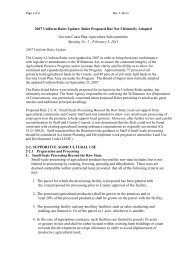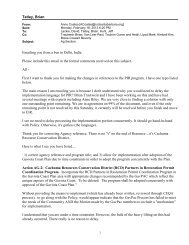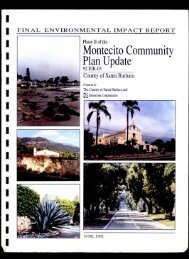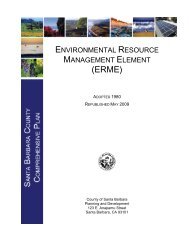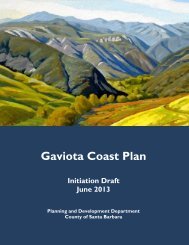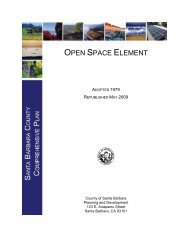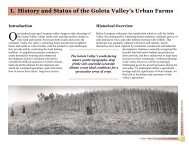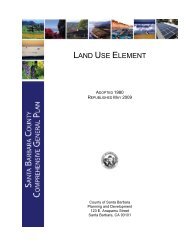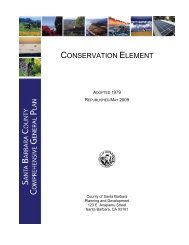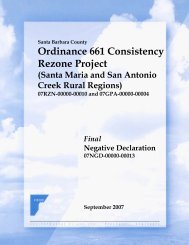Gaviotia layout 4 - PM 7.0 - Ocean and Coastal Policy Center ...
Gaviotia layout 4 - PM 7.0 - Ocean and Coastal Policy Center ...
Gaviotia layout 4 - PM 7.0 - Ocean and Coastal Policy Center ...
Create successful ePaper yourself
Turn your PDF publications into a flip-book with our unique Google optimized e-Paper software.
Introduction<br />
p <br />
Introduction<br />
In recent years, public attention has become increasingly focused on the l<strong>and</strong> use <strong>and</strong><br />
resources of “The Gaviota Coast” — the last largely undeveloped stretch of coastline in<br />
Southern California. With more than 100,000 acres of coastline, ranch <strong>and</strong> forest l<strong>and</strong><br />
between the City of Goleta <strong>and</strong> V<strong>and</strong>enberg Air Force Base, the region has been widely<br />
recognized for its tremendous <strong>and</strong> unique beauty, extraordinary ecological importance,<br />
<strong>and</strong> agricultural <strong>and</strong> cultural heritage.<br />
In 1999-2003, the U.S. National Park Service conducted a feasibility study for a national<br />
seashore or similar federal presence. In a report to Congress in March 2004, the Park<br />
Service found the Gaviota Coast suitable for inclusion in the National Park System, but it<br />
did not find its inclusion to be feasible. Still, the genie was out of the bottle.<br />
A growing, vocal constituency began calling for increased Gaviota planning <strong>and</strong> conservation,<br />
believing that without some intervention, the region would succumb to growth pressure<br />
<strong>and</strong> urbanization. Southern California’s coastal history, local politics <strong>and</strong> a few high profile<br />
coastal development projects fueled that concern. Environmental groups launched<br />
campaigns to “Save the Gaviota Coast,” while public <strong>and</strong> private financial support grew for<br />
the voluntary purchase of l<strong>and</strong> <strong>and</strong> agricultural conservation easements, as well as for<br />
cooperative projects to restore creeks <strong>and</strong> watersheds.<br />
Meanwhile, people who owned l<strong>and</strong> <strong>and</strong> made their livelihood on the coast became<br />
increasingly alarmed about government interference. New laws <strong>and</strong> regulations were passed<br />
at each level of government, dem<strong>and</strong>ing that agricultural l<strong>and</strong>owners plan <strong>and</strong> pay for<br />
protecting creeks, water quality, <strong>and</strong> endangered wildlife on their property. Environmental<br />
groups <strong>and</strong> elected officials were advocating l<strong>and</strong> use controls, habitat restoration <strong>and</strong><br />
public access trails. Wary of more regulation <strong>and</strong> coastal access requirements <strong>and</strong> weary<br />
of public meetings <strong>and</strong> hearings, l<strong>and</strong>owners organized to resist outside intervention <strong>and</strong><br />
more government controls.<br />
In the midst of this growing conflict, a group of Gaviota l<strong>and</strong>owners began talking about<br />
how local people <strong>and</strong> organizations could determine the future of Gaviota, based on a<br />
shared set of goals, rather than just arm wrestling in endless public debates <strong>and</strong> campaigns.<br />
The discussion exp<strong>and</strong>ed to include people with a broad range of interests, <strong>and</strong> in late<br />
2001, the Gaviota Coast Study Group was formed.<br />
The Study Group is self-selected <strong>and</strong> is not aligned with any organization. People were<br />
invited to participate who were willing to listen, contribute <strong>and</strong> try to work out differences.<br />
This included a balanced representation from Gaviota ranch, farm <strong>and</strong> l<strong>and</strong>owner interests,<br />
local environmental <strong>and</strong> conservation interests, staff observers from local, state <strong>and</strong> elected<br />
officials, <strong>and</strong> occasional public or private advisors. Twice a month for more than three<br />
years, we met privately <strong>and</strong> declined media attention as we explored ways the Gaviota<br />
Coast could be understood, planned <strong>and</strong> managed, by private <strong>and</strong> public interests, for the<br />
benefit of all.




